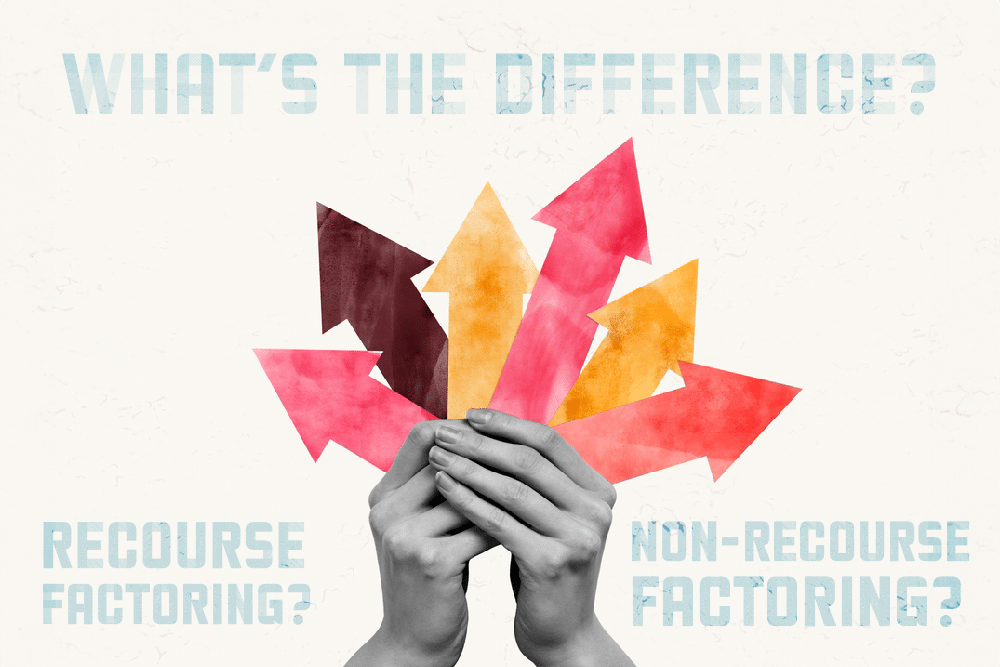
As you explore your invoice factoring options, two terms you’ll see are “recourse factoring” and “non-recourse factoring.” Understanding the difference between the two can help keep more money in your pocket and ensure your business receives the level of payment protection it needs. You’ll learn how they work and how to choose the right one for your business on this page.
How Factoring Works
Invoice factoring accelerates payment on your B2B invoices. Instead of waiting weeks or more for your clients to pay their invoices, you sell them to an invoice factoring company like Viva Capital instead.
You receive most of the invoice’s value right away. Although every company operates a bit differently, Viva offers advances of up to 100 percent of an invoice’s value and can even provide you with payment on the day you submit your invoice.
You’re free to spend the money however you wish. Many businesses use it for crucial expenses, such as payroll or inventory. Then, when your client pays their invoice, you receive the remaining sum minus a small factoring fee. Whereas anything between one and five percent of an invoice’s value is standard, Viva Capital has rates as low as 0.25 percent.
You control which invoices you factor and how much you factor. Most businesses are approved, including newer businesses and those without a strong credit history, because factoring companies are more concerned with the creditworthiness of the entity paying the invoice – your client.
Enhancing Cash Flow: Understanding Your Factoring Options
In business finance, understanding the nuances between recourse and non-recourse factoring is pivotal for managing cash flow and accounts receivable effectively. Invoice factoring, a crucial mechanism for immediate cash acquisition, hinges on selling unpaid invoices to factoring companies, offering a lifeline for businesses grappling with cash flow interruptions. The key differences between the two types of factoring—recourse and non-recourse—lie in the allocation of risk associated with non-payment by debtors. With recourse factoring, businesses retain the credit risk if the debtor fails to pay, potentially needing to buy back the invoice or cover the bad debt. Conversely, non-recourse factoring transfers the risk of debtor non-payment to the factoring company, typically at a higher fee due to the additional risk the company assumes. This distinction not only affects the terms of the factoring agreement and influences the type of factoring suitable for your business based on your risk tolerance and financial strategy. Factoring companies may perform credit checks to mitigate risks, and the choice between recourse and non-recourse factoring could pivot on factors such as invoice back terms, eligibility for non-recourse factoring, and the perceived credit risk of your accounts receivable. Ultimately, selecting the right factoring company—whether for recourse or non-recourse factoring—demands a comprehensive understanding of these differences, the benefits of each form of factoring, and how they align with your business’s needs for managing unpaid invoices and enhancing cash flow.
What Is the Difference Between Recourse and Non-recourse Factoring?
No matter what you do, there is always some risk that your customer won’t pay their invoice. The invoice factoring types – recourse and non-recourse factoring – refer to which party accepts the risk of non-payment with a factored invoice.
What’s the Risk of Non-Payment?
Around four percent of a business’s receivables will become non-collectible on average, Sage reports. There are vast differences between industries and individual companies. For instance, top-performing organizations may write off less than one percent of balances due to bad debt, while others can hit eight percent or more.
Regardless of which method you select, factoring helps mitigate the risk to some degree. This is because factoring companies perform credit checks on your clients before factoring any invoices. That way, you know in advance how much credit your business can extend to a client without exposing your company to unnecessary risk.
Additionally, factoring companies collect the balances for you. At Viva Capital, we address this from a customer service standpoint, always ensuring your clients receive the best possible care and support. That means we follow up with them and make it as easy as possible for them to pay. This approach also accelerates payment from the client side and helps create stronger, more positive relationships that reduce the likelihood of non-payment.
Recourse Definition: What is Recourse Factoring?
With recourse factoring, your business absorbs the loss if your customer doesn’t pay their invoice. This is the most common type of factoring, and it’s usually much more affordable.
Because you’ve already been paid for the invoice by your factoring company, you’re responsible for ensuring it’s paid back in some fashion. Each company has different guidelines. At Viva Capital, you can typically choose between one of the following:
- Your company buys back the unpaid invoice.
- You swap the unpaid invoice out for another of equal value.
- You deduct the amount from your reserve funds until it is paid in full.
Non-Recourse Definition: What is Non-Recourse Factoring?
With non-recourse factoring, the factoring company absorbs the loss if your customer doesn’t pay their invoice. Non-recourse factoring tends to be more expensive because the factoring company is accepting the risk.
There’s no process here like there is for recourse factoring. You can usually continue factoring as you normally would, though invoices for the non-paying client’s invoices will be ineligible for factoring.
Hybrid Definition: What is Hybrid Factoring?
Hybrid factoring fuses recourse and non-recourse factoring. Each company handles it differently. In some cases, you can alternate between recourse and non-recourse factoring. Other times, a certain percentage of an invoice qualifies for non-recourse factoring, and any value over the determined amount is treated as recourse factoring.
Recourse vs. Non-Recourse Factoring: Which is Better?
Neither recourse nor non-recourse factoring is better. Because there are pros and cons to each type of factoring, it’s more a matter of choosing the best solution for your needs.
When Recourse Factoring May Be Better
You may feel like recourse factoring is a better fit for your business if:
- Your clients are reliable. There’s minimal risk of non-payment, and you’re comfortable absorbing the loss if someone doesn’t pay.
- You want lower fees. Recourse factoring is less expensive because the factoring company is accepting less risk.
- You want higher advance rates. Because there’s less risk for the factoring company, you can usually receive significantly higher advances with recourse factoring.
When Non-Recourse Factoring May Be Better
You may feel like non-recourse factoring is a better fit for your business if:
- Your clients aren’t always reliable. Perhaps your industry is volatile, or you have concerns that specific customers may not pay within the required timeframe or may not pay at all. Non-recourse factoring can provide you with peace of mind.
- You can’t afford any risk of non-payment. Businesses operating with tight margins sometimes prefer non-recourse factoring because it ensures the company can keep moving forward without concern over adjusting budgets or running short on cash.
Get a Complimentary Invoice Factoring Quote from Viva Capital
Most businesses we work with at Viva Capital prefer recourse factoring because it keeps more cash in their pockets and allows them to maximize their advances. However, we also offer non-recourse factoring in certain situations. For instance, our transportation factoring clients may choose either type. If you’d like to learn more or get started, request a complimentary rate quote.
- The Pros and Cons of Working with a Factoring Company - December 23, 2025
- Why Your Construction Payment Practices Build or Break Trust - October 28, 2025
- Top Business Growth Financing Options by Stage - September 12, 2025

